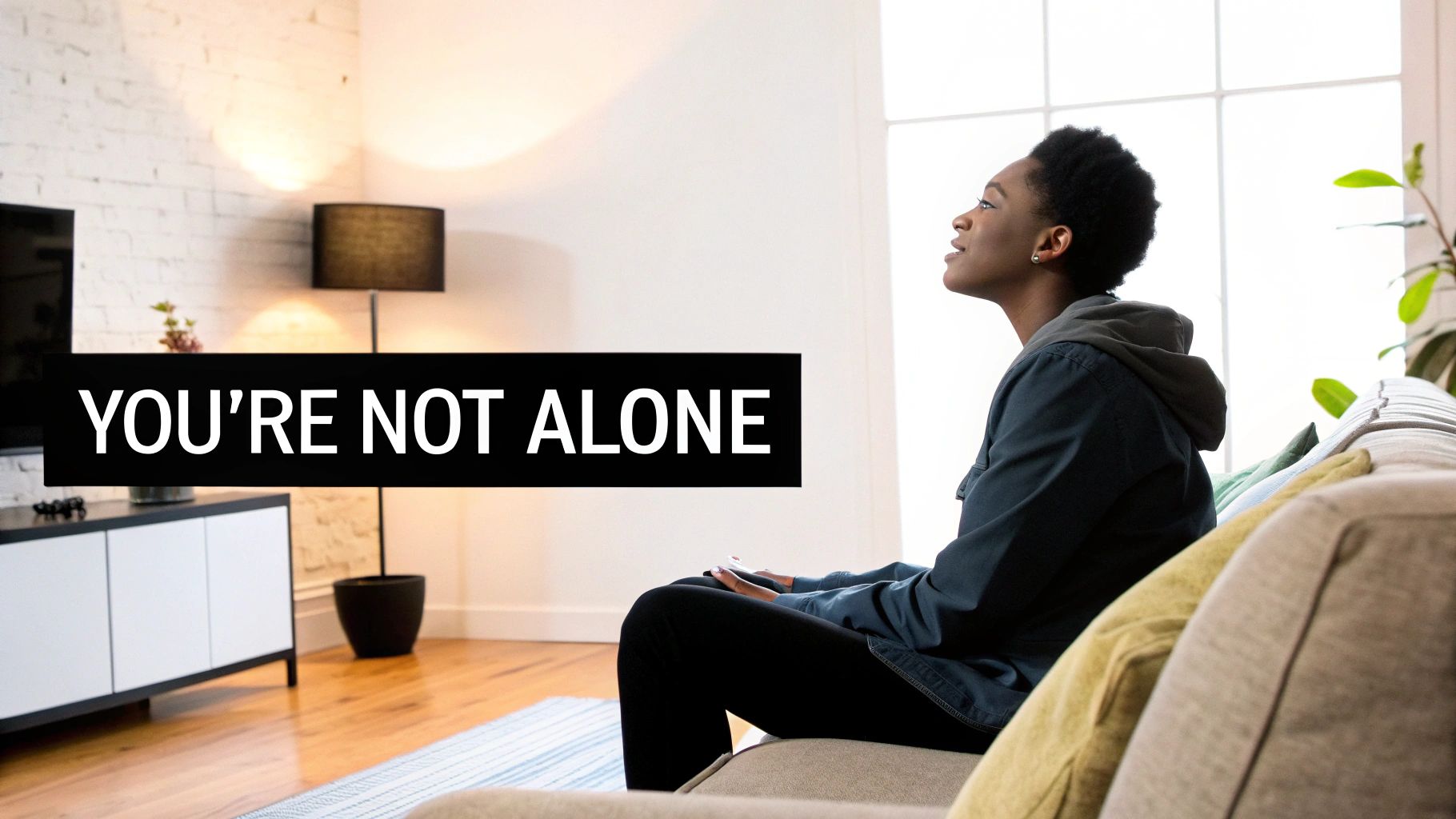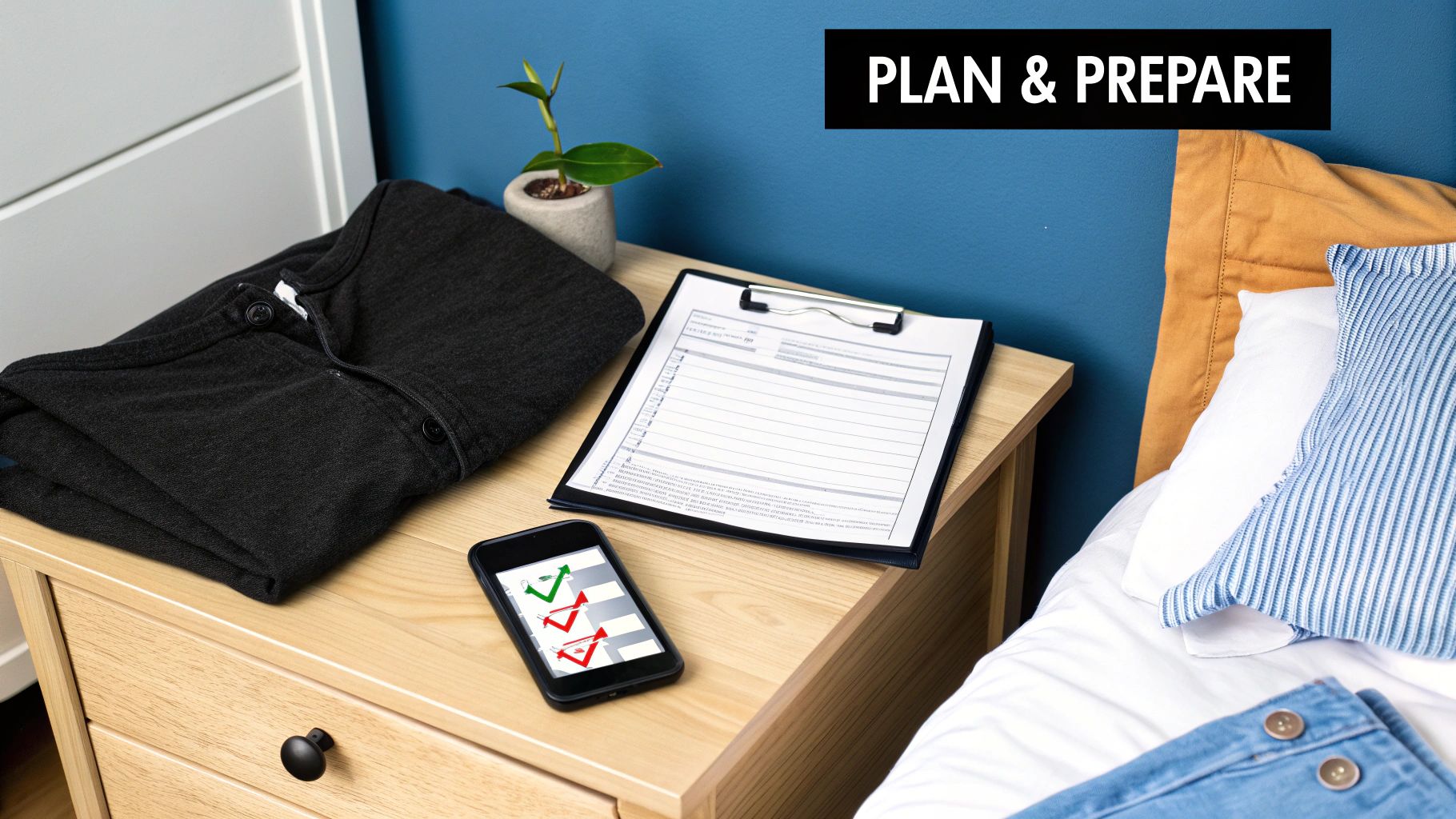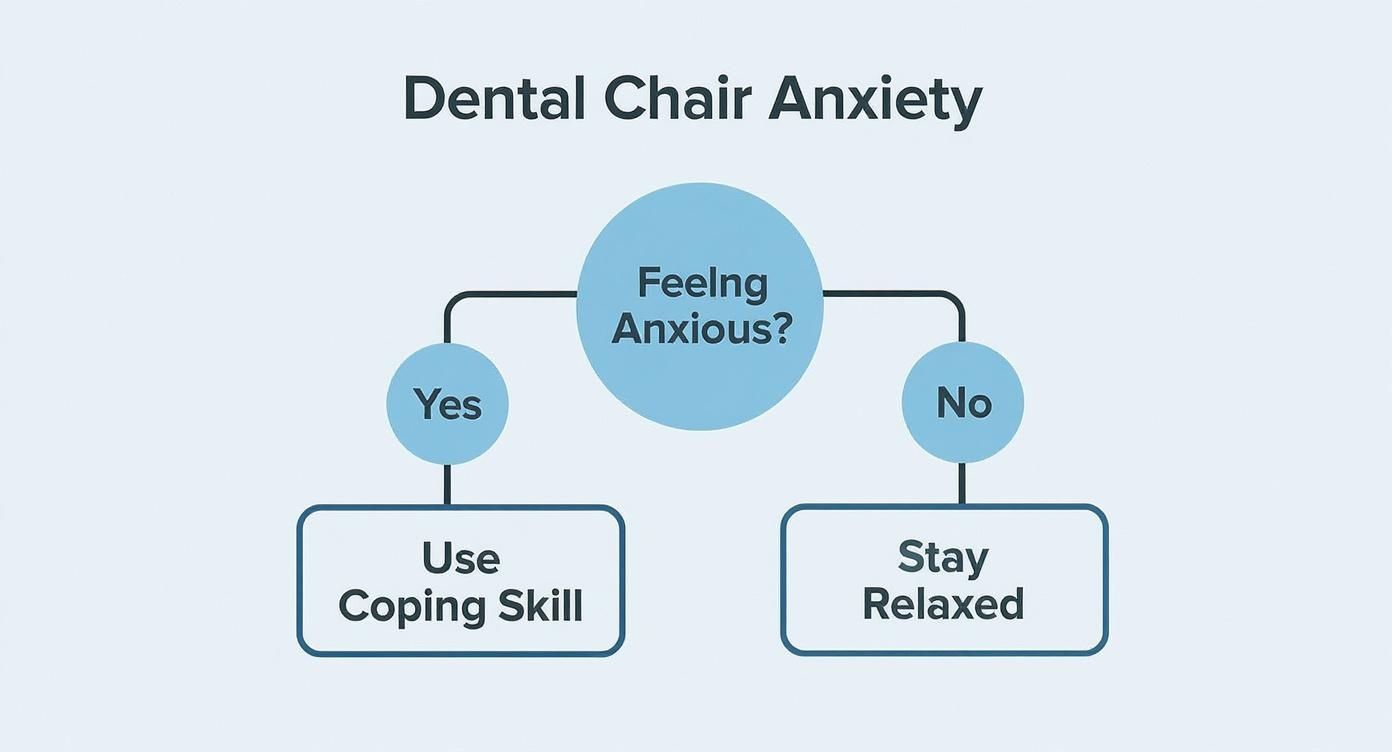How to Overcome Dental Anxiety: Proven Strategies
- Caterina Rutter
- Nov 1
- 12 min read
Overcoming dental anxiety starts with a proactive plan. It's about combining specific preparation strategies, clear communication with your dental team, and having practical coping skills ready for when you're in the chair. This approach helps you shift from feeling powerless to feeling in control, which can completely transform your dental appointments for the better.
Acknowledging Your Fear Is the First Step
If the thought of a dental visit makes your heart race, the first step is to acknowledge that feeling without judgment. Trying to ignore it or feeling ashamed only gives the fear more power. By validating your own feelings, you open the door to understanding them and, ultimately, overcoming them.

This isn't just a "feeling"—it has a real impact on oral health. Dental anxiety affects a significant portion of the global population. Current estimates show about 15.3% of adults worldwide experience it. Of those, 12.4% have high anxiety, and 3.3% suffer from a severe dental phobia. These numbers show that what you're experiencing is a shared and recognized challenge.
Unpacking the Roots of Dental Fear
To effectively manage anxiety, you must first identify your specific triggers. For many, the fear stems from a negative experience, often during childhood. A painful procedure or a dismissive dentist can create a lasting impression.
Here are the most common triggers and an actionable first step for each:
Fear of Pain: This is often the primary concern, fueled by past experiences or outdated ideas about dentistry. Action: Prepare a list of questions about modern pain management techniques to ask your dentist.
Loss of Control: Lying back in a dental chair can create a feeling of vulnerability. Action: Plan to establish a non-verbal "stop" signal with your dentist before treatment begins.
Embarrassment: Many people feel ashamed about the condition of their teeth and worry about being judged. Action: Write down this concern to share with the dental team. A good team will respond with reassurance, not judgment.
Sensory Overload: The unique sounds and smells of a dental office, especially the drill, can trigger panic. Action: Add noise-canceling headphones and a playlist or podcast to your appointment checklist.
Pinpointing your triggers allows you to create a targeted plan. Once you know the specific obstacles, you can implement practical solutions.
Shifting from Fear to Action
Acknowledging your fear is the starting point for creating a concrete plan. This mental shift is crucial—it moves you from being a passive victim of anxiety to an active partner in your own healthcare.
Taking time to understand your anxiety is not a weakness; it's the foundation for building a successful strategy. It empowers you to communicate your needs clearly and work with your dental team to create a safe and comfortable environment.
Recognizing your fear is a significant achievement. Exploring mental health resources can provide additional coping strategies. Your journey begins with this act of self-awareness. From here, you can build the confidence needed to care for your smile without fear. This guide will provide the actionable steps to make that a reality.
How to Prepare for a Calmer Dental Visit
Gaining control over your dental anxiety begins well before you arrive at the clinic. Proactive preparation can turn passive worry into a structured plan, building your confidence from the start. It’s about making small, intentional choices that have a significant impact on your mindset.

This preparation phase is your first opportunity to address your fears directly. By taking these steps, you transform a dreaded event into a manageable part of your healthcare, creating a foundation of calm that you can carry with you into the dental chair.
Finding the Right Dental Partner
Not all dental practices are equally equipped to handle significant anxiety. Finding a team that prioritizes patient comfort is the most critical step you can take. Treat your search for a new dentist like an interview—you are deciding if they are the right fit for your needs.
When you contact a potential office, be direct about your anxiety. Their response will be very telling. A supportive team will reply with empathy and practical solutions, not a dismissive "you'll be fine."
Here are specific questions to ask to assess their approach:
"I have significant dental anxiety. What specific steps does your team take to help patients like me feel comfortable?" This open-ended question prompts them to describe their actual process.
"Do you offer longer appointments for anxious patients to avoid feeling rushed?" Flexibility in scheduling is a positive indicator.
"What comfort amenities do you provide, such as blankets, headphones, or sedation options?" This identifies the practical tools they have available.
"Can I schedule a brief 'meet-and-greet' visit to see the office and meet the dentist before any treatment?" A practice willing to do this demonstrates a commitment to building trust first.
This initial conversation is crucial for finding a genuine partner in your oral health.
Strategic Scheduling and Pre-Visit Rituals
The logistics of your appointment day can greatly influence your anxiety levels. The objective is to eliminate as many external stressors as possible so you can focus your energy on staying calm.
Actionable Scheduling Tips:
Book an early appointment. The first slot of the day minimizes waiting time, which is often when anxiety escalates.
Create a calming pre-visit routine. On the morning of your appointment, dedicate 30 minutes to an activity that grounds you. This could be listening to a specific playlist, doing a short guided meditation, or enjoying a cup of herbal tea.
Think of your pre-appointment routine as a buffer zone. It's dedicated time to protect your peace of mind before you even leave the house, making it that much easier to hold onto that calm throughout the visit.
What to Do on Appointment Day
Your choices on the day itself directly impact your body’s stress response. A few simple adjustments can help prevent your nervous system from going into overdrive.
Small Choices, Big Impact:
Dress for Comfort: Wear loose, non-restrictive clothing. Feeling physically comfortable helps prevent the added stress of feeling confined.
Skip Stimulants: Avoid caffeine and high-sugar foods for several hours before your visit. These can increase your heart rate and amplify feelings of jitteriness.
Plan a Post-Visit Reward: Arrange something enjoyable for after your appointment, like watching a movie or visiting a favorite park. This shifts your focus from enduring the visit to anticipating a positive outcome.
These strategies are also highly effective for helping children. Preparing them positively can prevent deep-seated fears from forming. For more advice, see our guide on managing dental anxiety in kids. By turning preparation into a proactive strategy, you reclaim power over the situation and build a framework for a better dental experience.
Using Your Voice to Reduce Dental Fear
A primary driver of dental anxiety is the feeling of having no control. Your most powerful tool for regaining that control is your own voice.
When you communicate your needs, you transform the appointment from a one-sided procedure into a collaborative partnership. Your dental team becomes your ally, working with you to ensure your comfort. Speaking up isn't being difficult; it's being an engaged patient. Your dentist wants to know how you're feeling so they can provide the best possible care.
Establish Your In-Chair Control System
The most effective way to feel in control during a procedure is to establish a non-verbal "stop" signal before any work begins. This is a game-changer if you worry about being unable to speak up once treatment is underway.
Agree on a simple gesture, such as raising your left hand. Practice it once with the dentist or assistant to confirm you are on the same page. This signal means "I need a brief pause," and a good dental team will honor it immediately and without question.
Knowing you have a pre-agreed way to pause at any time can instantly lower your anxiety. It puts you back in the driver's seat and makes sure you never feel trapped or ignored during your treatment.
This single action reinforces that you are in control of the situation, a crucial step in overcoming dental anxiety in the moment.
How to Start the Conversation with Your Dentist
Knowing what to say can be as challenging as summoning the courage to say it. Having a few prepared phrases makes it easier to break the ice and ensure your primary concerns are addressed.
Use these scripts to start the conversation:
To open up: "Before we begin, I want to let you know that I experience a lot of anxiety about dental work. Could we take a moment to discuss how we can make this a more comfortable experience for me?"
To understand the procedure: "It would really help my anxiety if you could walk me through each step before you do it. Knowing what to expect is very helpful for me."
To address pain concerns: "My main fear is pain. Can you tell me about the pain management options you use and assure me that we'll stop immediately if I feel anything?"
To request breaks: "I find it helpful to take a short break every 10-15 minutes to reset. Is that something we can plan for?"
Using clear, specific language helps your dental team understand exactly how to support you. This collaborative approach is a key component of excellent patient care, which is often found when you know why to choose a family dentist.
Your Past Experiences Matter—A Lot
When discussing your dental history, include your emotional experiences. Research confirms that past dental events, particularly during childhood, significantly impact adult anxiety levels.
Negative dental encounters are strongly linked to higher dental fear. In fact, individuals who report such experiences are more than twice as likely to avoid dental care entirely. You can review the findings on this research for more details.
Telling your dentist that a previous procedure was painful or that a former provider was dismissive provides a clear roadmap of what to avoid. This isn't complaining; it's providing vital context that helps them customize their approach so old fears are not re-triggered.
Real-Time Techniques for Staying Grounded in the Chair
You’ve prepared, communicated with your dentist, and now you’re in the chair. This is the moment to use practical, in-the-moment techniques to manage anxiety as it arises.
These are not complex exercises. They are simple, discreet actions you can take to prevent anxiety from spiraling. The goal is not to eliminate nervousness but to manage it effectively. Think of these as your personal toolkit for staying centered.
Master Your Breath to Master Your Nerves
Anxiety often causes shallow, rapid breathing, which signals your brain to panic. You can interrupt this cycle by controlling your breath. Deep, slow breathing stimulates the vagus nerve, which helps slow your heart rate and promotes a state of calm.
One of the most effective and discreet methods is box breathing:
Inhale: Breathe in slowly through your nose for a count of four.
Hold: Gently hold that breath for a count of four.
Exhale: Breathe out slowly and completely through your mouth for a count of four.
Hold: Pause for a final count of four before beginning the next cycle.
Repeat this cycle three to five times, focusing only on the counting and the sensation of your breath. This simple pattern breaks the panic feedback loop and provides a steady anchor for your mind.
Engage Your Senses to Ground and Distract
Grounding techniques pull your focus away from anxious thoughts and back to the present moment by engaging your senses. Distraction works alongside this by giving your brain a different task.
Your Sensory Escape Plan:
Tune Out Triggers: The sounds of a dental office are a common trigger. Bring noise-canceling headphones with a pre-downloaded playlist, podcast, or audiobook. This creates a personal audio bubble that blocks out unsettling noises.
Carry a Grounding Object: Keep a small, tangible item in your pocket, such as a smooth stone or a stress ball. When you feel overwhelmed, hold it and focus entirely on its texture, temperature, and weight. This tactile feedback shifts your focus from internal fear to a neutral, external object.
Practice Mindful Observation: Pick a spot on the ceiling and study its details—patterns, colors, or imperfections. Alternatively, focus solely on the sensation of wiggling your toes inside your shoes. These small acts of mindfulness occupy your brain with the present moment.
The secret to good distraction is picking something that requires just enough brainpower to keep you engaged, but not so much that it adds to your stress. You're gently guiding your focus, not forcing it.
For severe anxiety that can lead to panic attacks, learning specific coping strategies for panic attacks can be invaluable. Many of these skills are adaptable to the dental chair.
Understanding Your Sedation and Support Options
Sometimes, even with the best preparation and coping skills, dental fear can feel insurmountable. That is perfectly okay.
When anxiety remains a significant barrier, sedation dentistry and professional therapy are powerful and effective options. They are not last resorts but established tools designed to help you receive necessary care comfortably and safely.
Demystifying Sedation Dentistry
Sedation dentistry is designed to ensure you remain physically and emotionally comfortable during your procedure. It allows the dental team to perform their work efficiently while you stay in a calm, relaxed state, transforming a stressful experience into a peaceful one.
It’s not an all-or-nothing choice. Sedation exists on a spectrum, with options that can be tailored to your specific anxiety level and the required treatment. Understanding what's available empowers you to have a confident discussion with your dentist.
To clarify the options, here is a comparison of the most common types of sedation used in dentistry.
Comparing Sedation Dentistry Options
Sedation Type | How It's Administered | Level of Consciousness | Best For |
|---|---|---|---|
Nitrous Oxide | Inhaled through a small nose mask | Fully conscious but relaxed; effects wear off quickly. | Mild to moderate anxiety, shorter procedures, and patients who need to drive themselves home. |
Oral Sedation | A prescribed pill taken before the appointment | Awake but deeply relaxed; you may have little memory of the procedure. | Moderate to severe anxiety or for longer, more complex treatments. |
IV Sedation | Administered directly into a vein | A "twilight" state of deep relaxation; you have little to no memory of the procedure. | Severe anxiety, dental phobias, or extensive surgical procedures. |
The goal is to select the method that provides the appropriate level of comfort and safety for your individual needs.
Sedation isn't about being "put to sleep." It's about creating a state of profound calm that allows you to receive necessary care without fear. It’s a tool that empowers you to prioritize your health.
To learn more, our detailed guide on how to relieve your dental anxiety with sedation dentistry provides a comprehensive overview.
This decision tree offers a simple visual guide for thinking through your anxiety level and corresponding strategies.

As the visual illustrates, building a foundation of proactive coping skills is your first and most powerful line of defense, even when anxiety is high.
Looking Beyond the Chair: Professional Therapy
If your dental anxiety is a symptom of a deeper phobia or anxiety disorder that impacts your quality of life, working with a therapist can provide long-term solutions.
A therapist specializing in phobias can introduce you to proven techniques like Cognitive-Behavioral Therapy (CBT). CBT helps you identify the negative thought patterns driving your fear and replace them with more rational, balanced ones. It equips you with the mental tools to dismantle anxiety before it takes hold. Studies have shown that a structured CBT program can reduce high dental anxiety by as much as 50%. Therapy provides a safe space to address these fears and build lasting resilience.
Answering Your Questions About Dental Anxiety
Even with a solid plan, a few questions may remain. Getting clear, direct answers can provide the final piece of confidence you need before your visit.
Here are answers to the most common concerns.
Will My Dentist Judge Me for My Fear or for Not Visiting Sooner?
No. A compassionate dental professional will never judge you for being anxious or for the length of time since your last visit. We understand that dental anxiety is a real medical condition that prevents many people from seeking care.
When a patient is open about their fears, it helps us provide better, more empathetic care. We view your decision to come to our office as a courageous step forward. Our sole focus is on helping you achieve good oral health, not on judging your past.
What if I Have a Panic Attack in the Dental Chair?
Having a plan is the best way to manage this fear. Before treatment begins, establish a non-verbal "stop" signal with your dentist, such as raising your hand. This keeps you in control.
If you feel panic rising, use the signal immediately. Your dental team is trained to respond. They will stop what they are doing, giving you the space you need to reset.
In that moment, focus on your breath. Use the box breathing technique: inhale for four counts, hold for four, exhale for four, and hold for four. This simple action physically calms your nervous system and helps you feel grounded.
We will wait patiently and provide support until you feel ready to continue—or decide to stop for the day. There is never any pressure.
Can Children Develop Dental Anxiety?
Yes, children can develop a fear of the dentist. This often stems from sensing a parent's anxiety, hearing negative stories, or having one difficult experience. The good news is that you can take proactive steps to prevent this fear from developing.
Effective Strategies for Kids:
Choose a Pediatric Dentist: These specialists excel at creating fun, positive, and child-friendly environments that make dental visits feel like an adventure.
Use Positive Language: Avoid words like "pain," "hurt," or "shot." Instead, frame the visit positively: "We're going to count your teeth" or "check your superhero smile."
Normalize Dental Visits: Read children's books or watch cartoons about positive dental experiences. Let them accompany you to one of your own routine cleanings to see how calm and normal it is.
Building a positive foundation early is the best way to ensure a lifetime of good oral health free from anxiety.
At Beautiful Dentistry, our entire practice is designed to be a comfortable, judgment-free zone where you feel safe, heard, and in control. If you're ready to partner with a team that understands, we are here for you. Schedule your visit with us today and ask about our gentle approach and new patient specials.


Comments